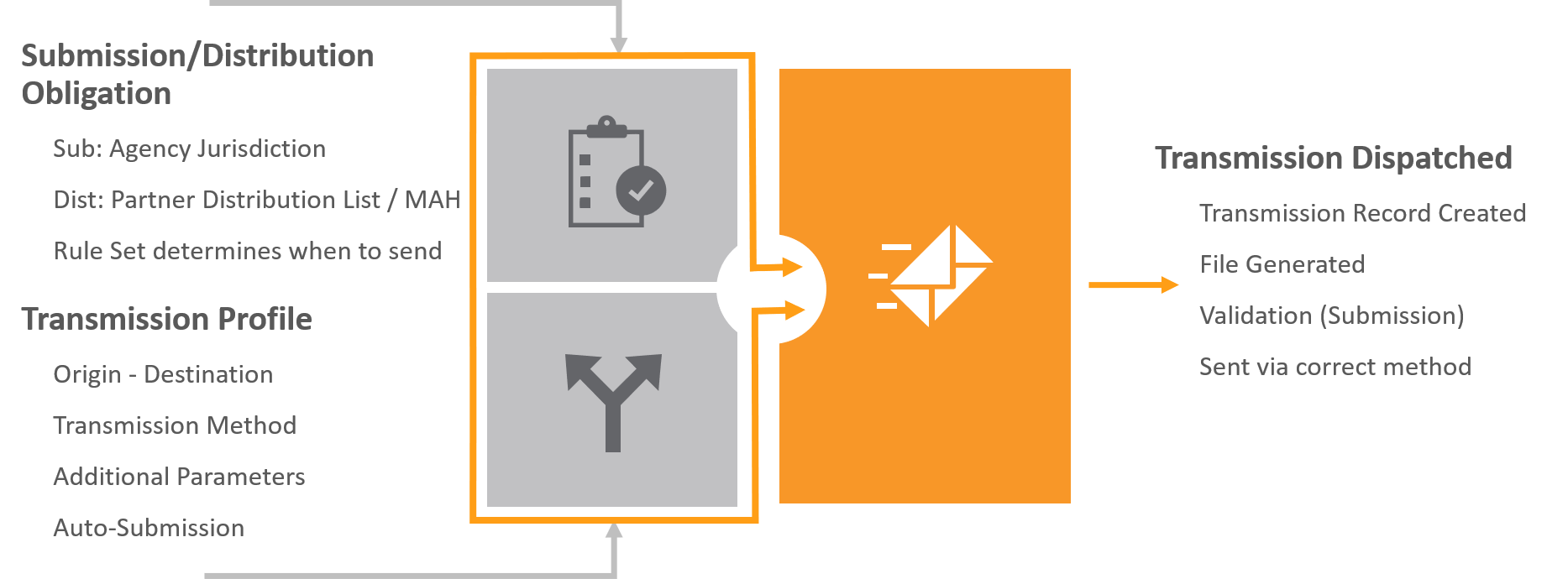Safety allows you to exchange Individual Case Safety Reports (ICSRs) with trading partners, using an AS2 gateway or manually.
About ICSR Transmissions
You can transmit ICSRs using the Transmission object for Early Notifications, Submissions, or Distributions. Preconfigured workflows support tracking transmissions outside of your Vault and sending transmissions electronically or manually. You can access and manage Early Notifications, Submissions, and Distributions from the Transmissions tab.
ICSR Transmission Types
You can transmit ICSRs to trading partners or regulatory authorities using the following Transmission types:.
- Submissions: Use Submissions to send ICSRs to regulatory authorities, including the standard agencies supported by Vault, and custom agencies. Your Admin must configure an AS2 Connection for each agency gateway.
- Distributions: Use Distributions to share ICSRs with non-regulatory authorities, such as a partner, site, and market authorization holder.
- Early Notifications: Use Early Notifications to send ICSRs to partners and agencies with whom you have an agreement to share source documents or initial Case information before a Case reaches the Approval state.
ICSR Transmission Generation
Vault generates an ICSR Transmission for a Case when either the Evaluate Reporting Obligations action or the Evaluate Early Notification Obligations action runs on a Case.
Evaluate Reporting Obligations
The Evaluate Reporting Obligations action generates ICSR Transmissions and runs when a Case moves to the Approved state. When this action runs, Vault does the following:
- Checks if the Case requires reporting to agencies or other organizations. The Case must match a reporting rule and Transmission Profile for a reporting destination.
- Maps any missing Study registrations from the Study library to the Case.
- Evaluates reporting obligations on all Case data modifications, including for all subsequent evaluations.
If configured by your Admin, auto-submissions may run from the Case level as part of case processing workflow. You can also manually create Submissions and Distributions.
Evaluate Early Notification Obligations
If you have an agreement with a partner or agency to share the details of a Case before it has reached the Approved state, you can run the Evaluate Early Notification Obligations action on the Case. When this action runs, Vault performs the same actions as for Submissions and Distributions described above with the following exceptions:
- Vault considers a Case as eligible for early notification for early reporting to a partner or agency if it matches a reporting rule that contains an Early Notification reporting rule parameter.
- Vault ignores reporting rules that do not contain an Early Notification reporting rule parameter.
- Vault does not set the Due Date on Early Notifications.
Logically Delete Non-Submittable Transmissions on Subsequent Evaluations
If your Admin has enabled logical deletion of non-submittable Transmissions, Vault prevents over-reporting of Cases without having to manually remove or update Submissions. Whenever you rerun the Evaluate Reporting Obligations action on a global Case or Localized Case for a Localization with a blank Assessment Generation method, Vault does the following for Transmissions generated by the reporting rules engine:
- Generates Transmissions for any submittable reporting obligations not previously created by the reporting rules engine.
- To prevent duplication of Rule Engine-created Transmissions, for all destinations except the FDA, Vault considers all Transmission Profile and Destination pairs. For the FDA, Vault considers Transmission Profiles within a Registration Type (Investigational or Marketing) and Destination pairs.
- Updates any previously created Transmissions that are no longer submittable to Deleted.
- This change does not apply to Transmissions in the Completed, E2B ACK Accepted, and E2B ACK Warning states.
- Updates the Due Dates on all submittable Transmissions.
- Updates the Auto-Submit field.
- Adds a new version of any previously created Transmission Creation Message, appending details of whether any of the reporting rules passed or if all the rules failed.
Note: This does not apply to Localized Cases that contain a Localization with an Assessment Generation method of Case Product Registration. For these Cases, unused Submissions move to the Deleted state by the Generate Local Reporting Details action. For more information on Submission Generation and Linking for PMDA Localized Cases, see Report to the PMDA.
If this feature is not enabled in your Vault, Vault generates any newly submittable Transmissions, but does not update any previously generated Transmissions. You must manually update Due Dates and delete any Transmissions that no longer meet reporting obligations
ICSR Transmission Methods
Each ICSR Transmission uses the Transmission Method specified in the associated Transmission Profile, including the following methods:
